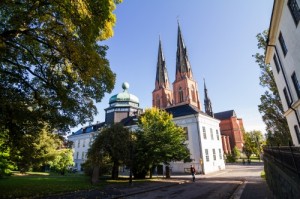Return to main Workshop 2014 page
Download a PDF version of the programme.
| Wednesday 2 July 2014, University Main Building, Room IX | |
|---|---|
| 11.30 | REGISTRATION opens followed by LUNCH |
| 12.15 | Opening remarks by the organizers |
| 12.30-13.10 | Session 1 chaired by Martin Fredriksson, Linköping University (SE):
Balázs Bodó, University of Amsterdam (NL) A Qualitative and Quantitative Analysis of Scientific Shadow Libraries Commentator: Jorge Contreras, American University (US) |
| 13.15-13.55 | Matt Stahl, University of Western Ontario (CA)
Tactical Destabilization for Economic Justice: The American Recording Industry, Aging R&B Performers, and the 1984-2004 Royalty Reform Movement Commentator: Toni Lester, Babson College (US) |
| 14.00-14.40 | Rasmus Fleischer, Stockholm University (SE)
Performers’ and/or Producers’ Rights? The Pre-history of the Rome Convention, 1930-1960 Commentator: Matt Stahl, University of Western Ontario (CA) |
| 14.45-15.00 | COFFEE BREAK |
| 15.05-15.45 | Session 2 chaired by Lucky Belder, Utrecht University (NL):
Louis Pahlow, Johann Wolfgang Goethe-Universität (DE) Stability and Instability in the Patent Law System: Patent Pooling, Industrial Concentration and Competition Policy in Germany (1890-1930) Commentator: Gabriel Galvez-Béhar, Université Lille 3 (FR) |
| 15.50-16.30 | Nicolas Chachereau, Université de Lausanne (CH)
How to Patent a Chemical? The Instability of a New Type of Intellectual Property (Switzerland 1888-1907) Commentator: Joshua Sarnoff, DePaul University (US) |
| 16.35-17.15 | Amanda Scardamaglia, Swinburne University of Technology (AU)
The Historical Movement, Transmission and Transformation of Trade Mark Law in Colonial Australia Commentator: Marianne Dahlén, Uppsala University (SE) |
| 17.15 | CLOSE |
| 17.30-19.30 | RECEPTION at GUSTAVIANUM
If you’re still hungry after the reception, dinner is on your own. You’ll find a list of different restaurants in your workshop package. |
| Thursday 3 July 2014, University Main Building, Room IX | |
|---|---|
| 9.15-10.30 | Roundtable on “Interdisciplinarity in Intellectual Property Research”
A discussion with Gabriel Galvez-Behar, Debora Halbert, Dan Hunter, and Stina Teilmann-Lock. Chair: Eva Hemmungs Wirtén |
| 10.35-11.15 | Session 3 chaired by Maurizio Borghi, Bournemouth University (UK):
Xiobao Shen, University of Edinburgh (UK) A Paradox – “Chinese Characteristics” of Imitating Western Intellectual Property Regime Commentator: Dan Hunter, Queensland University of Technology (AU) |
| 11.20-12.00 | Christian Katzenbach and Sarah Herweg, Alexander von Humboldt Institute for Internet and Society, Berlin (DE)
Stabilizing and Contesting the Instable through Discourse: Attributions of Imitation and Innovation in the Digital Games Sector Commentator: Saara Taalas, Linneaus University (SE) |
| 12.05-13.05 | LUNCH |
| 13.10-13.50 | Session 4 chaired by Peter Decherney, University of Pennsylvania (US):
Friedeman Kawohl, Bournemouth University (UK) Fürstenthal v. Hirschfeld – A conflict between a pre-modern religious censorship regime and a modern secular copyright regime in 19th-century Prussia Commentator: Jens Eriksson, Uppsala University (SE) |
| 13.55-14.35 | Marie-Claude Felton, McGill University (CA)
Writing According to the Law: A Comparative Study of Literary Legislations and Authorial Ventures in France, England and Germany in the 18th Century Commentator: Martha Woodmansee, Case Western Reserve University (US) |
| 14.40-15.20 | Jorge Contreras, American University (US)
Stories of Gene Patenting Commentator: Daithi Mac Sithigh, Newcastle University (UK) |
| 15.25-15.45 | COFFEE BREAK |
| 15.50-16.30 | Session 5 chaired by Debora Halbert, University of Hawaii at Manoa (US):
David Lametti, McGill University (CA) Unstable Art: The Curious Case of Claude Théberge Commentator: Lucky Belder, Utrecht University (NL) |
| 16.35-17.15 | Megan Richardson and Julian Thomas, The University of Melbourne and Swinburne University of Technology (AU)
The ‘Face of Things’: Image Rights in the Age of Digital Reproduction Commentator: Jaime Stapleton (UK) |
| 17.20-18.00 | Aura Bertoni and Maria Lillà Montagnani, Bocconi University (IT)
Public Architectural Art and its Spirits of Instability Commentator: Jan von Bonsdorff, Uppsala University (SE) |
| 18.00 | CLOSE |
| 19.30 | Workshop DINNER at LINNEANEUM |
| Friday 4 July 2014, University Main Building, Room IX | |
|---|---|
| 09.30-10.10 | Session 6 chaired by Megan Richardson, University of Melbourne
Patrick Burkart and Jonas Andersson Schwarz, Texas A&M University (US) and Södertörn University College (SE) Post-Privacy and Ideology Commentator: Julian Thomas, Swinburne University of Technology (AU) |
| 10.15-10.55 | Michael Birnhack, Tel-Aviv University (IL)
The Cost of Judicial Snapshots: The Case of Israeli Fair Use Commentator: Peter Decherney, University of Pennsylvania (US) |
| 11.00-11.30 | COFFEE BREAK |
| 11.35-12.15 | Session 7 chaired by Helle Porsdam, Copenhagen University (DK):
Marc Perlman, Brown University (US) ‘Commercial’ vs. ‘Noncommercial’ in Copyright Law and the Arts: An Unstable Distinction in Times of Rapid Technological Change Commentator: Maurizio Borghi, Bournmouth University (UK) |
| 12.20-13.00 | Debora Halbert and Jake Dunegan, University of Hawaii at Manoa and Institute for the Future, Palo Alto (US)
Intellectual Property for the Neurocentric Age: Towards a neuropolitics of IP Commentator: Robin Williams, University of Edinburgh (UK) |
| 13.05-13.15 | Concluding remarks and handing over to Peter Decherney for 2015. |
| 14.00- | LUNCH |
We gratefully acknowledge the generous sponsorship of the Swedish Foundation for the Humanities and Social Sciences.
 Uppsala, Sweden July 2-4, 2014
Uppsala, Sweden July 2-4, 2014 Queen Mary Journal of Intellectual Property – Special ISHTIP 2014 Issue
Queen Mary Journal of Intellectual Property – Special ISHTIP 2014 Issue